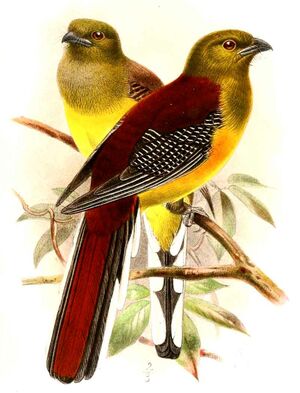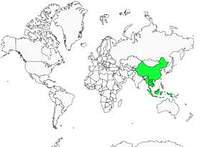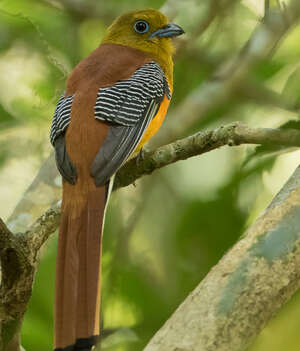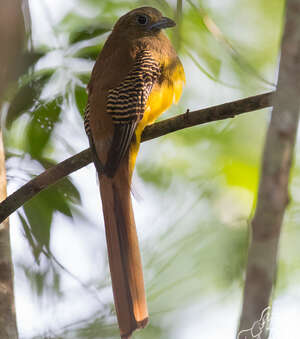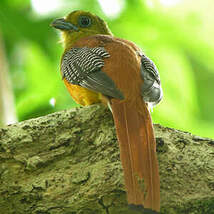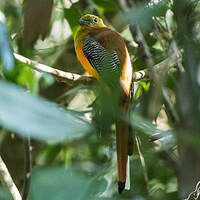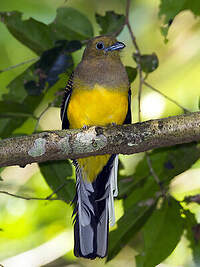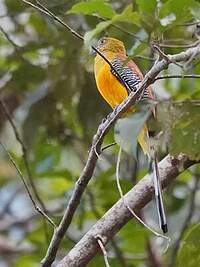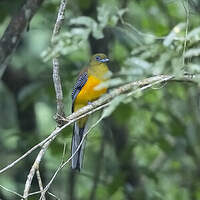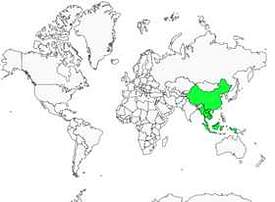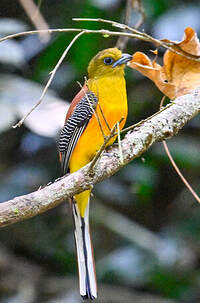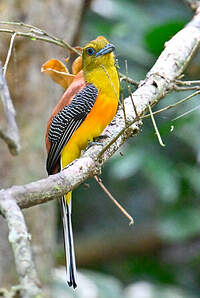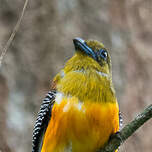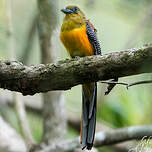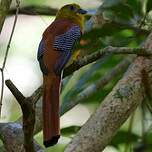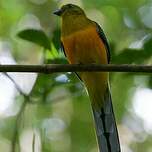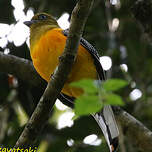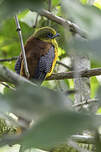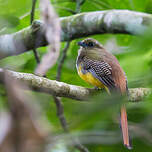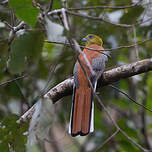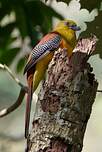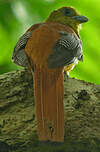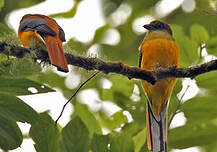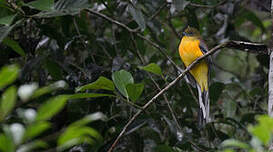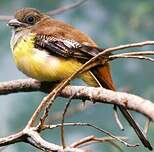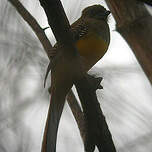Orange-breasted Trogon
Harpactes oreskios - Trogon à poitrine jaune
Identification
The Orange-breasted Trogon is the perfect example of differences in observation or identification: the Anglo-Saxons called it the Orange-breasted Trogon, and the scientific name, Harpactes oreskios, can be translated as the bandit that dwells in the mountain! Conrad Jacob Temminck, Dutch ornithologist (1778-1858) who gave it its name in 1823 paid more attention to its habitat than its color. Rather small, 25 to 26 cm, with a marked dimorphism but less evident than other trogonid species, the male has an olive-green head tinted in pale yellow that contrasts with a large cobalt blue orbital circle, the iris is dark brown and the beak takes on the same color as the orbital circle. The throat and upper chest are yellow-olive, a thin white band separates the upper chest from the orange-yellow chest, and the belly reverts to light yellow. The neck is olive-green, the mantle and back feature a sheen chestnut brown, and the rump is pale brown. The black coverts have fairly wide white vermiculations, and the characteristic black remiges of trogonids are bordered in white at the edges. The central rectrices are a brownish-red with black markings at the ends, and the three outermost rectrices are white, slightly showing the second and third black rectrices. From the front, the tail looks white with black tips in the middle. The female has a grey-green head rather than olive-green, the beak and orbital circle remain cobalt blue, the throat and upper chest are grey with the same white band visible, the lower chest and belly are yellow without the orange reflections of the male. The back and mantle are a pale brown, and the dark brown coverts are vermiculated with light chamois horizontal stripes slightly wider than those of the male; the rectrices remain the same as those of its companion.Young ones have rufous back and mantle with pale tinge, yellow breast and belly are speckled with white down while coverings ranging from black to brown have only faint light vermiculations, it will be very hard to distinguish sexes. Four subspecies are recognized, ssp oreskios which gives its name to the species; ssp oreskios uniformis which has entirely olive-green head, also throat and breast, white band becomes pale yellow, female has crown and nape grey-green whereas throat and breast are greyish, visible band on the breast is white, back has less pronounced light chestnut colour than male; ssp oreskios nias presents few differences to uniformis, male has very dark olive-green head whereas female's is darker notably on the back, bill is larger; ssp dulitensis looks alike to uniformis yet breast of both sexes is strongly green dominant and size is smaller. Orange-breasted Trogon
Subspecific information 5 subspecies
- Harpactes oreskios oreskios (Java)
- Harpactes oreskios stellae (sw China, s Myanmar and Indochina)
- Harpactes oreskios uniformis (Malay Pen. and Sumatra)
- Harpactes oreskios dulitensis (nw Borneo)
- Harpactes oreskios nias (Nias I.. off w Sumatra.)
Foreign names
- Trogon à poitrine jaune,
- Trogón pechinaranja,
- republicano-de-peito-laranja,
- Orangebauchtrogon,
- narancsbegyű malájtrogon,
- Groenkoptrogon,
- Trogone pettoarancio,
- orangebröstad trogon,
- Olivenhodetrogon,
- dravčík olivový,
- trogon oranžovoprsý,
- Gulbuget Trogon,
- mandariinitrogoni,
- trongon de pit carbassa,
- sędzioł złotobrzuchy,
- Зеленоголовый азиатский трогон,
- Luntur harimau,
- ヤマキヌバネドリ,
- 橙胸咬鹃,
- นกขุนแผนอกสีส้ม,
- 橙胸咬鵑,
Voice song and call
Habitat
Dietfeeding habits
The Orange-breasted Trogon is mainly insectivorous: orthopterans, hemiptera (cicadas), phasmes, spiders, all types of larvae, caterpillars, as well as lizards. It is known to hunt from a branch or a perch but is often seen on the ground and sometimes with other species. Occasionally it will supplement its diet with fruit.
Reproduction nesting
In Java, nesting periods are spread across almost the whole year, between February, May, June and October, February and April in Myanmar or from January to May in the Malay Peninsula. Nests are often excavated in dead trees at low heights (between 1 and 4 meters) and lined with bark, twigs and sometimes in dead bamboos. The clutch is usually two eggs, although there have been cases of clutches of four. There is still no information available about incubation and feeding of chicks.
Geographic range
The Orange-breasted Trogon has a wide distribution range: ssp oreskios is confined to Java in Indonesia; ssp uniformensis has the largest range and can be found in Sumatra in Indonesia, in the Malay Peninsula, in northern and central Vietnam, in southern China especially in southern Yunnan, in southern and eastern Myanmar; in Thailand and in southern Indochina, a ssp called stellae is sometimes described with a slightly longer tail but it seems that it is just a variant of uniformis. Finally, ssp nias is only found on the island of Nias west of Sumatra.
Threats - protection
IUCN conservation status
concern
in the Wild
threatened
evaluated
Orange-breasted Trogon appears to be better adapted to living in human surroundings than other trogons, however the scourges of human expansion, pollution, deforestation, and runaway population growth are decreasing its habitat.
Sources of information
- IOC World Bird List (v15.1), Gill, F and D Donsker (Eds). 2025-12-07.
- A Natural history of the Trogonidae, Joseph M.Forshaw Albert Earl Gilbert
- Scientific Birds Names, James A.Jobling
- Vol. 6 - Handbook of the Birds of the World, Josep del Hoyo-Andrew Elliott-Jordi Sargatal
- xeno-canto, Sharing bird sounds from around the world,
- Avibase, Lepage Denis
- BirdLife International, BirdLife International
- HBW Alive,
- Oriental Bird Club,
- The internet Bird Collection,
- Wikipédia, Wikipedia, The Free Encyclopedia
Other sources of interest
 Specification sheet created on
01/08/2023 by Anne et Gabriel Leboff
Specification sheet created on
01/08/2023 by Anne et Gabriel LeboffTranslation by AI Oiseaux.net
© 1996-2025 Oiseaux.net
- Accipitriformes
- Aegotheliformes
- Anseriformes
- Apodiformes
- Apterygiformes
- Bucerotiformes
- Caprimulgiformes
- Cariamiformes
- Casuariiformes
- Charadriiformes
- Ciconiiformes
- Coliiformes
- Columbiformes
- Coraciiformes
- Cuculiformes
- Eurypygiformes
- Falconiformes
- Galliformes
- Gaviiformes
- Gruiformes
- Leptosomiformes
- Mesitornithiformes
- Musophagiformes
- Nyctibiiformes
- Opisthocomiformes
- Otidiformes
- Passeriformes
- Pelecaniformes
- Phaethontiformes
- Phoenicopteriformes
- Piciformes
- Podargiformes
- Podicipediformes
- Procellariiformes
- Psittaciformes
- Pterocliformes
- Rheiformes
- Sphenisciformes
- Steatornithiformes
- Strigiformes
- Struthioniformes
- Suliformes
- Tinamiformes
- Trogoniformes

